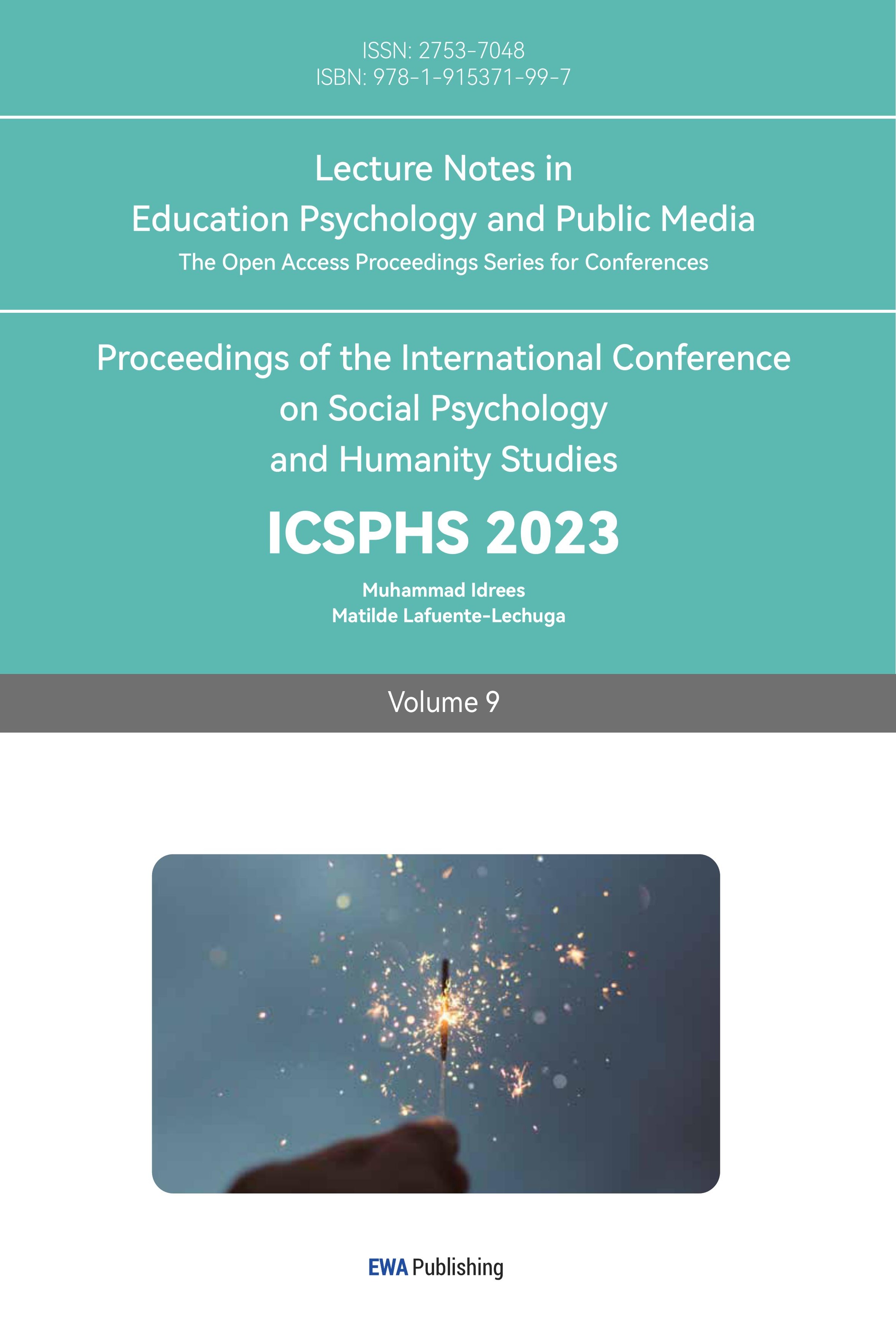References
[1]. National Bureau of Statistics, 2021.
[2]. Du, Y., & Yang, C. (2015). Demographic transition and labour market changes: Implications for economic development in China. China's Economy: A Collection of Surveys, 25-44. https://doi.org/10.1002/9781118982433.ch3
[3]. White, M. S., Burns, C., & Conlon, H. A. (2018). The impact of an aging population in the workplace. Workplace health & safety, 66(10), 493-498. DOI:10.1177/2165079917752191.
[4]. Wang, J. X., & An, C. (2018). Global Ageing Facts, Impacts and Policy Responses. Chin. Soc. Secur. Rev, 4, 14-30.
[5]. National Bureau of Statistics, 2021.
[6]. China Statistical Yearbook, 2019.
[7]. Palmore, E. B., Fillenbaum, G. G., & George, L. K. (1984). Consequences of retirement. Journal of gerontology, 39(1), 109-116. https://academic.oup.com/geronj/article/39/1/109/562193
[8]. Wu, Y., Xu, C., & Yi, M. (2022). The Optimal Choice of Delayed Retirement Policy in China. Sustainability, 14(19), 12841. https://doi.org/10.3390/su141912841
[9]. Chen, X., Zhong, S., & Qi, T. (2020). Delaying retirement and China’s pension payment dilemma: based on a general analysis framework. IEEE Access, 8, 126559-126572. DOI: 10.1109/ACCESS.2020.3008520.
[10]. Le Garrec, G., & LHuissier, S. (2017). Differential mortality, aging and social security: delaying the retirement age when educational spillovers matter. Journal of Pension Economics & Finance, 16(3), 395-418. https://doi.org/10.1017/S1474747215000396
[11]. Yu Xinran & Su Fang. (2023). Analysis of the effects of Life expectancy and years of Education on the willingness to delay retirement: Based on the sample of the labor force about to retire. Northwest population (01), 43-58. DOI: 10.15884 / j.carol carroll nki. Issn 1007-0672.2023.01.004.
[12]. Interim Measures of The State Council on Retirement and Resignation of Workers, 1978.
[13]. Díaz-Giménez, J., & Díaz-Saavedra, J. (2009). Delaying retirement in Spain. Review of Economic dynamics, 12(1), 147-167. DOI: 10.1016/j.red.2008.06.001.
[14]. Yang F. (2021). A comparison of retirement policy systems in China, the United States and Japan under the background of aging and its implications. Western China (02),107-115. http://www.cnki.net
[15]. Hernaes, E., Markussen, S., Piggott, J., & Vestad, O. L. (2013). Does retirement age impact mortality? Journal of health economics, 32(3), 586-598. https://doi.org/10.1016/j.jhealeco.2013.03.001
[16]. Lee, H. H., & Shin, K. (2019). Nonlinear effects of population aging on economic growth. Japan and the World Economy, 51, 100963. https://doi.org/10.1016/j.japwor.2019.100963
Cite this article
Ren,F. (2023). The Economic Impact of Population Aging in China: Effectiveness of Delayed Retirement. Lecture Notes in Education Psychology and Public Media,9,346-352.
Data availability
The datasets used and/or analyzed during the current study will be available from the authors upon reasonable request.
Disclaimer/Publisher's Note
The statements, opinions and data contained in all publications are solely those of the individual author(s) and contributor(s) and not of EWA Publishing and/or the editor(s). EWA Publishing and/or the editor(s) disclaim responsibility for any injury to people or property resulting from any ideas, methods, instructions or products referred to in the content.
About volume
Volume title: Proceedings of the International Conference on Social Psychology and Humanity Studies
© 2024 by the author(s). Licensee EWA Publishing, Oxford, UK. This article is an open access article distributed under the terms and
conditions of the Creative Commons Attribution (CC BY) license. Authors who
publish this series agree to the following terms:
1. Authors retain copyright and grant the series right of first publication with the work simultaneously licensed under a Creative Commons
Attribution License that allows others to share the work with an acknowledgment of the work's authorship and initial publication in this
series.
2. Authors are able to enter into separate, additional contractual arrangements for the non-exclusive distribution of the series's published
version of the work (e.g., post it to an institutional repository or publish it in a book), with an acknowledgment of its initial
publication in this series.
3. Authors are permitted and encouraged to post their work online (e.g., in institutional repositories or on their website) prior to and
during the submission process, as it can lead to productive exchanges, as well as earlier and greater citation of published work (See
Open access policy for details).
References
[1]. National Bureau of Statistics, 2021.
[2]. Du, Y., & Yang, C. (2015). Demographic transition and labour market changes: Implications for economic development in China. China's Economy: A Collection of Surveys, 25-44. https://doi.org/10.1002/9781118982433.ch3
[3]. White, M. S., Burns, C., & Conlon, H. A. (2018). The impact of an aging population in the workplace. Workplace health & safety, 66(10), 493-498. DOI:10.1177/2165079917752191.
[4]. Wang, J. X., & An, C. (2018). Global Ageing Facts, Impacts and Policy Responses. Chin. Soc. Secur. Rev, 4, 14-30.
[5]. National Bureau of Statistics, 2021.
[6]. China Statistical Yearbook, 2019.
[7]. Palmore, E. B., Fillenbaum, G. G., & George, L. K. (1984). Consequences of retirement. Journal of gerontology, 39(1), 109-116. https://academic.oup.com/geronj/article/39/1/109/562193
[8]. Wu, Y., Xu, C., & Yi, M. (2022). The Optimal Choice of Delayed Retirement Policy in China. Sustainability, 14(19), 12841. https://doi.org/10.3390/su141912841
[9]. Chen, X., Zhong, S., & Qi, T. (2020). Delaying retirement and China’s pension payment dilemma: based on a general analysis framework. IEEE Access, 8, 126559-126572. DOI: 10.1109/ACCESS.2020.3008520.
[10]. Le Garrec, G., & LHuissier, S. (2017). Differential mortality, aging and social security: delaying the retirement age when educational spillovers matter. Journal of Pension Economics & Finance, 16(3), 395-418. https://doi.org/10.1017/S1474747215000396
[11]. Yu Xinran & Su Fang. (2023). Analysis of the effects of Life expectancy and years of Education on the willingness to delay retirement: Based on the sample of the labor force about to retire. Northwest population (01), 43-58. DOI: 10.15884 / j.carol carroll nki. Issn 1007-0672.2023.01.004.
[12]. Interim Measures of The State Council on Retirement and Resignation of Workers, 1978.
[13]. Díaz-Giménez, J., & Díaz-Saavedra, J. (2009). Delaying retirement in Spain. Review of Economic dynamics, 12(1), 147-167. DOI: 10.1016/j.red.2008.06.001.
[14]. Yang F. (2021). A comparison of retirement policy systems in China, the United States and Japan under the background of aging and its implications. Western China (02),107-115. http://www.cnki.net
[15]. Hernaes, E., Markussen, S., Piggott, J., & Vestad, O. L. (2013). Does retirement age impact mortality? Journal of health economics, 32(3), 586-598. https://doi.org/10.1016/j.jhealeco.2013.03.001
[16]. Lee, H. H., & Shin, K. (2019). Nonlinear effects of population aging on economic growth. Japan and the World Economy, 51, 100963. https://doi.org/10.1016/j.japwor.2019.100963









